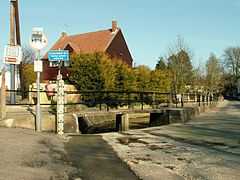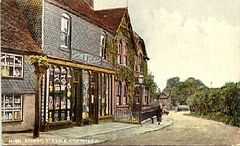Steeple Bumpstead
| Steeple Bumpstead | |
 The footbridge on the corner of Church Street, Steeple Bumpstead |
|
 Steeple Bumpstead |
|
| Population | c. 2000 |
|---|---|
| Civil parish | Steeple Bumpstead |
| District | Braintree |
| Shire county | Essex |
| Region | East |
| Country | England |
| Sovereign state | United Kingdom |
| Post town | HAVERHILL |
| Postcode district | CB9 7 |
| Dialling code | 01440 |
| Police | Essex |
| Fire | Essex |
| Ambulance | East of England |
| EU Parliament | East of England |
| UK Parliament | Saffron Walden |
Coordinates: 52°02′40″N 0°26′54″E / 52.0445°N 0.4484°ESteeple Bumpstead is a village and civil parish 3 miles (4.8 km) south of Haverhill in Braintree (district), Essex, England.
The parish church does not actually have a steeple, however the Congregational Church has a small Victorian one. It is believed that the steeple referred to was actually located on the A1307 close to what is now the Wixoe pumping Station.
History
Bumstead or Bumsted is Anglo-Saxon for "place of reeds". The Moot Hall is recorded in the Domesday Book.
The Knights Templar positioned themselves on the river.
There has been a long history on non-conformist belief in the village which continues to this day in the Congregational Church. A Bumpstead man was burnt to death in the parish for his beliefs. Along the Blois Road, leading from Bumpstead to Birdbrook, is a field that has been called the ‘Bloody Pightle’, and that is where he is believed to have been martyred. In 1527 John Tibauld and eight other village residents were seized and taken before the Bishop of London, charged with meeting together in Bower Hall to pray and read a copy of the New Testament. Although the non-conformists in the village were encouraged by the powerful Bendyshe family that lived at Bower Hall, even their influence could not save Tibauld. He was burned at the stake.
Having fallen into ruin after use as a ‘concentration camp’ in the First World War, Bower Hall was finally demolished in 1926 and the materials sold off. The great staircase found its way to the USA.
A Moot Hall, known as ‘the Old Schole’, symbolises Steeple Bumpstead. Built in 1592 by the inhabitants on land rented from the Crown, in the 1830s when it was ‘a school for farmers’ sons’ the villagers forcibly took possession of it, disputing the claim of George Gent of Moyns to have the right to appoint the headmaster. Eventually an Ecclesiastical Court upheld the villagers’ claim.
Steeple Bumpstead was one of the first villages in the country to have its own village policeman when County Policing came into being in Essex. In 1840, William Rattigan was one of the very first Essex Police Officers to be assigned a village beat. There was a police officer stationed in the village for 160 years from 1840 to 2000 when the last 'bobby', Ray Howard, retired. For years the village was a hotbed of trouble with many 'riots' and unrest during the agricultural strikes in 1914 and the 1920s. In fact the national agricultural strike of 1914 was started nearby in Castle Camps and the troubles spread to Steeple Bumstead which became a stronghold for the strikers.
Modern times

There are many facilities in Steeple Bumpstead for residents including a local village Mace store, a Post Office, a petrol station, an antiques shop, and a library in the aforementioned Moot Hall. Steeple Bumpstead is also fortunate enough to have its own medical practice providing first rate care to the community. In addition to these facilities, Steeple Bumpstead has two pubs, The Fox and Hounds and The Red Lion. Both have been refurbished, and are contributing to the quality of life in the village.
There are two churches, the Church of England parish church of St. Mary's and the Congregational Church, each offering various activities for all ages. St Mary's is a grade I listed building dating from the 11th century.[1]
Steeple Bumpstead has its own primary school, Stanley Drapkin Primary School, which in the latest Ofsted report was described as follows:
"This is an effective school which provides good value for money. Leadership and management are good. Pupils are happy, behave very well and enjoy their work. By the time they leave the school, pupils are achieving above-average standards overall. The teaching is good overall and this ensures that pupils enjoy learning and achieve well."
Steeple Bumpstead has a Scout Group: 1st Steeple Bumpstead Scouts which consists of a Beaver Colony, A Cub Pack and a Scout Troop. The group in total has circa 100 members. The Cub Pack and Scout Troop meet on Fridays while the Beaver Colony meets on Mondays. An article on 1st Steeple Bumpstead Scouts has recently been published by the Haverhill Echo written by a member of the Scout Troop on Work Experience. For further information consult The HCV Scout Website. There is also an active Brownies group, and a Girl Guides group.
Recently there has been much property development around Steeple Bumpstead including the addition of Freezes Barns, Old Hall Close and Suckling's Yard.
On the 14th June 2007, the areas close to the "Bumpstead Brook" were flooded due to the stream bursting its banks and many homes along Water Lane, Helions Bumpstead Road, The Ford and around Haverhill Road were flooded. The village was featured on the Friday 15 June BBC's "Look East" evening news as a result.
Steeple Bumpstead was also mentioned in the first pages of the 2007 novel "The Reavers" by George MacDonald Fraser.
Notable Residents
Nurse Edith Cavell had ties with Steeple Bumpstead occurred long before she became a nurse. During 1886, Edith was appointed governess to the four children of the Reverend Charles Powell, vicar of Steeple Bumpstead. The vicarage, where a stone plaque commemorates her stay, is no longer the residence of the local vicar, but it is still there, a private residence, on the corner of Chapel Street and Finchingfield Road. There is, in the 11th century village church, a plaque to Edith Cavell and there is also a road named after her. Nurse Cavell, who became a legend for bravery and sacrifice, died in Brussels on 12 October 1915, shot by a German firing squad for helping Allied soldiers to escape.
Colonel J. C. Humphrey, son of the village wheelwright, allegedly invented corrugated iron. He built and lived in the Iron House, North Street, which was sadly demolished in the 1960s. At one time Humphreys Ltd of London claimed to be the ‘largest works in the world’ and held a Royal Warrant as ‘supplier to His Majesty King Edward VII’.
Josh Moseley, of 28 lion meadow. Famous mathematician and founder of the Ina Giron fan club
See also
References
- ↑ "Name: PARISH CHURCH OF ST MARY THE VIRGIN List entry Number: 1166315". English Heritage. Retrieved 20 April 2014.
External links
![]() Media related to Steeple Bumpstead at Wikimedia Commons
Media related to Steeple Bumpstead at Wikimedia Commons
| ||||||||||||||||||||||||||